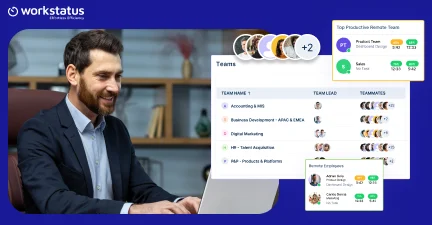Table of Contents
Workforce analytics is not just about counting hours or measuring performance – it provides you with different decisions on how to thrive. With the help of workforce management solutions and strategies based on analyzing your workforce data, you can enhance efficiency, utilization, and morale.
Besides, the workforce analytics market is projected to grow at a CAGR of 14.4% from 2024 to 2034, reaching an estimated value of USD 9,160.2 million by 2034.
Here’s what workforce analytics can do for you:
- Find patterns in a team’s performance.
- Identify the future contingencies and requirements for the workers.
- Decide who to hire, how to train, and whom to retain.
- Improve teamwork relations and cohesion.
- Cut operation costs and increase productivity.
Let’s take a journey through this blog, which explains how workforce analytics can help improve business data-driven decisions.
Let’s dive into it, shall we?
Switch from Traditional Analysis to Predictive Workforce Analytics
The traditional workforce metrics approach relies primarily on history, so it cannot address current and emerging issues. Predictive analytics as an application overcomes this since it relies on sophisticated models that can predict trends rather than merely react to them and the future workforce.
Limitations of Traditional Workforce Analysis
Traditional workforce analysis uses historical and limited data analysis, where reports are the usual outcome, giving stagnant information. This approach:
- Lacks the ability to envision the future in terms of workforce and or its issues.
- Tends to rely more on previous performance than on future planning.
- Does not include real-time data processing, which results in slow decision-making processes.
- Has restricted capabilities in handling change in the business environment.
What Makes Predictive Analytics a Revolutionary Approach?
Predictive workforce analytics is not limited to the performance history of an employee or even a team or department but is used to look into the future. Its key advantages include:
- Proactive Decision-Making: Offers clues as to what may lie ahead regarding risks and possibilities.
- Data-Driven Forecasting: Assists in planning for the workforce, such as the supply of human resources or the shortage of human resources skills.
- Enhanced Accuracy: Incorporates historical data, trends, and overstated complex analysis to provide accurate forecasts.
- Personalized Insights: Adapts action plans to align with employee behavior and organizational characteristics.
Real-World Applications of Predictive Workforce Analytics
Workforce management across different fields is changing due to predictive analytics. Examples include:
- Improved Retention Strategies: Identify employees with high turnover intentions and implement retention strategies.
Example: A retail chain uses predictive analytics to detect employees likely to leave and offers tailored incentives to keep them. - Optimal Resource Planning: Outsource workloads to avoid overwhelming employees with too much work.
Example: A software development firm uses analytics to determine peak demand periods and hires contractors during those times to balance workload. - Employee Performance Forecasting: Select talent to maximize performance and develop leaders.
Example: A tech company uses data to identify employees with high leadership potential and invests in training programs. - Workforce Cost Management: Account for overtime expenses or production rate fluctuations when setting budgets.
Example: A manufacturing plant analyzes past production data to predict overtime costs and adjusts staffing accordingly.
Consequently, predictive analytics provides organizations with the means of proactively managing the workforce, enhancing productivity, and introducing improvements at the workplace.
Why is Workforce Analytics Crucial for Businesses?
A manufacturing company had been struggling with inefficiencies and high turnover, relying on instinct to make staffing decisions. The traditional approach couldn’t keep up as customer demand grew, leading to declining productivity and poor workforce optimization.
That’s when they decided to adopt workforce analytics, and the results were precise.
With the power of workforce analytics, the company was able to transform decision-making in several key areas:
- Enhancing Decision-Making With Data: Managers gained real-time employee performance insights, allowing them to make informed decisions about staffing and training.
- Identifying Workforce Trends and Opportunities: Data highlighted which teams needed support and which excelled, enabling proactive adjustments.
- Boosting Productivity and Reducing Costs: By optimizing staffing levels based on data, they reduced overtime and maximized productivity, lowering labor costs.
Check out our video on the importance of workforce analytics for business:
Using Workforce Analytics to Solve Business Challenges
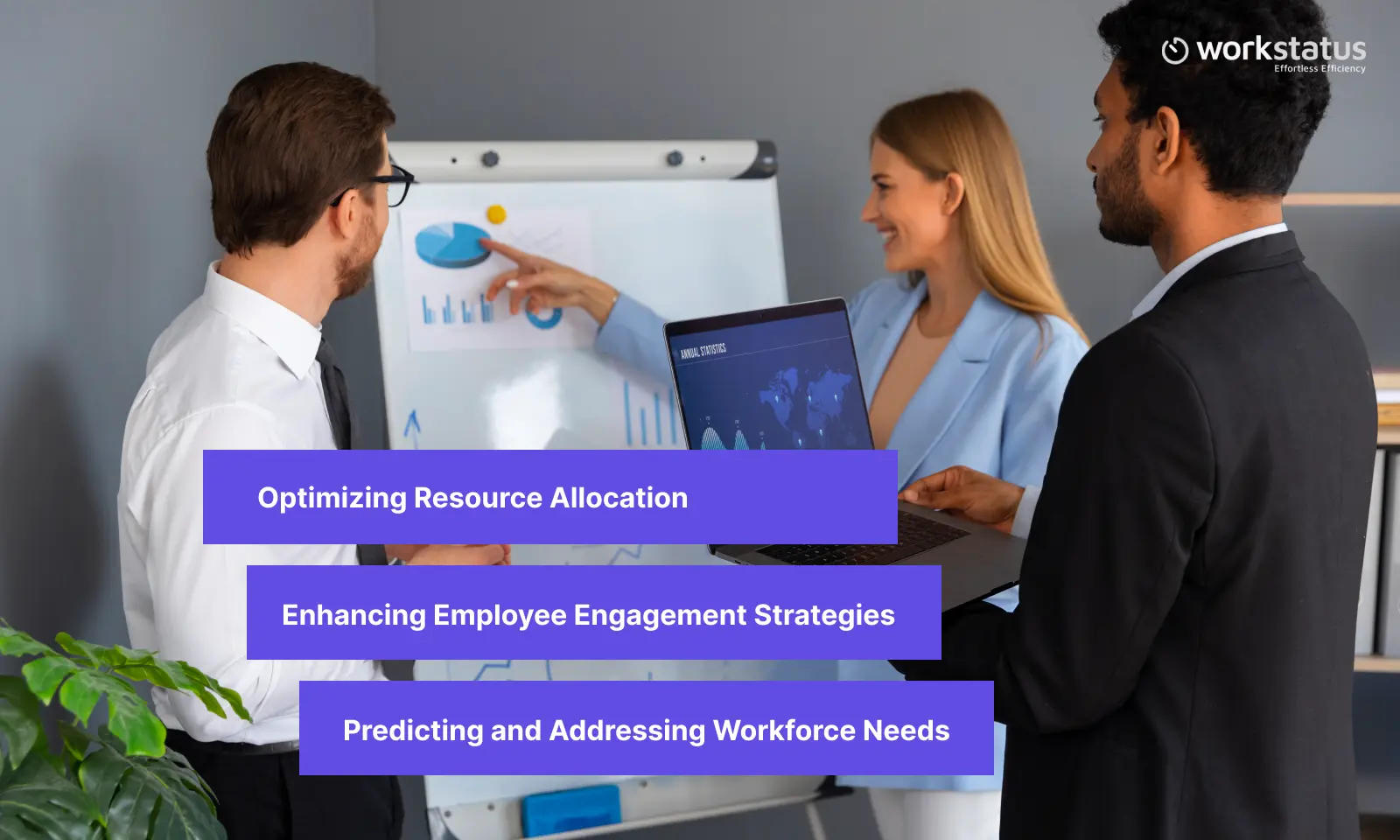 Now guided by data-based decision-making, the company tackled key challenges head-on.
Now guided by data-based decision-making, the company tackled key challenges head-on.
- Optimizing Resource Allocation: Workforce analytics helped them sync staffing levels with demand, hire temporary workers during peak times, and cut back on unnecessary labor costs.
- Enhancing Employee Engagement Strategies: They tracked employee satisfaction, leading to better retention through recognition programs and more development opportunities.
- Predicting and Addressing Workforce Needs: The company used analytics to forecast its future hiring needs and skills gaps and stay ahead of the competition.
Thus, workforce analytics enabled the company to streamline operations, enhance employee satisfaction, and position itself for future success.
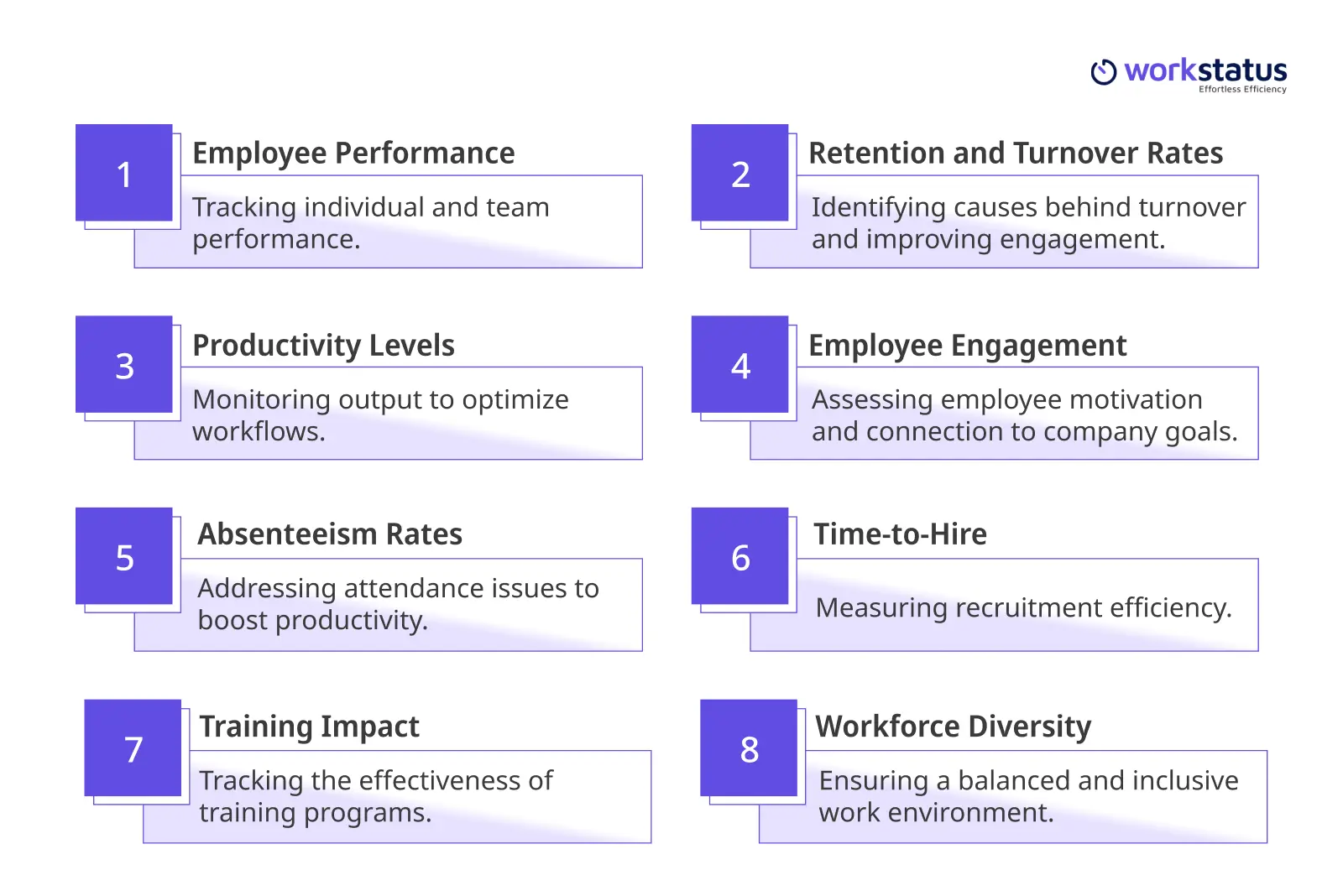
How Workstatus Simplifies Workforce Analytics?
Workstatus simplifies workforce analytics with real-time data, configurable reporting, and insight into key business performance indicators. These aspects make it one of the best employee data analysis tools.
The platform is designed to enhance decision-making, boost productivity, and ensure efficient workforce management through advanced features. Workstatus empowers businesses to make data-driven decisions that drive efficiency and profitability.
Here are the prime features that simplify workforce analytics:
Actionable Workforce Analytics
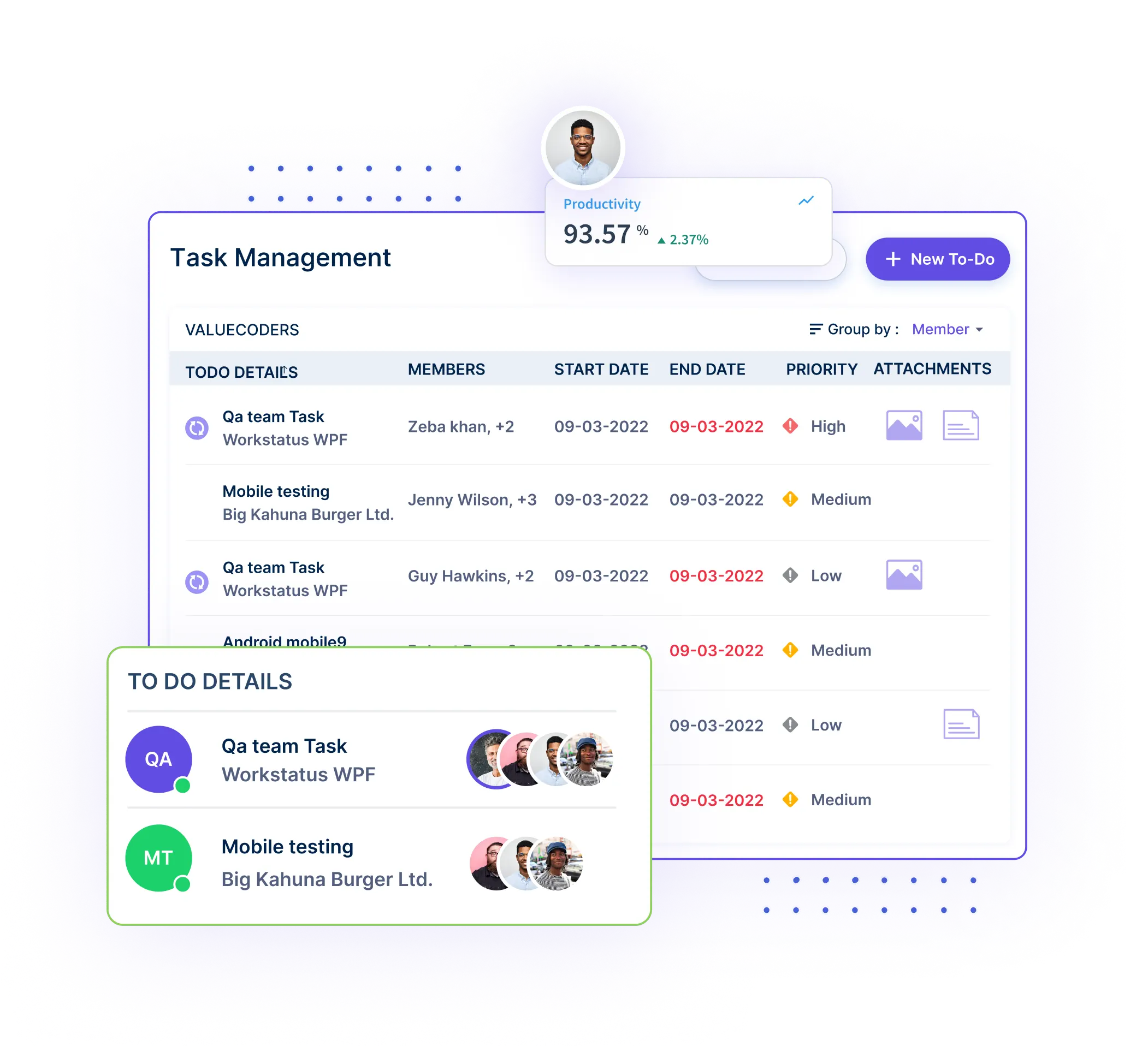 Workstatus provides actionable workforce analytics to assist businesses in reaching insightful conclusions regarding employee productivity, performance and attendance.
Workstatus provides actionable workforce analytics to assist businesses in reaching insightful conclusions regarding employee productivity, performance and attendance.
Easy-to-read dashboards and customizable reports enable managers to identify areas for improvement promptly, tell whether the staffing is correct, and make informed decisions to enhance workforce efficiency.
In-Depth Productivity Reports
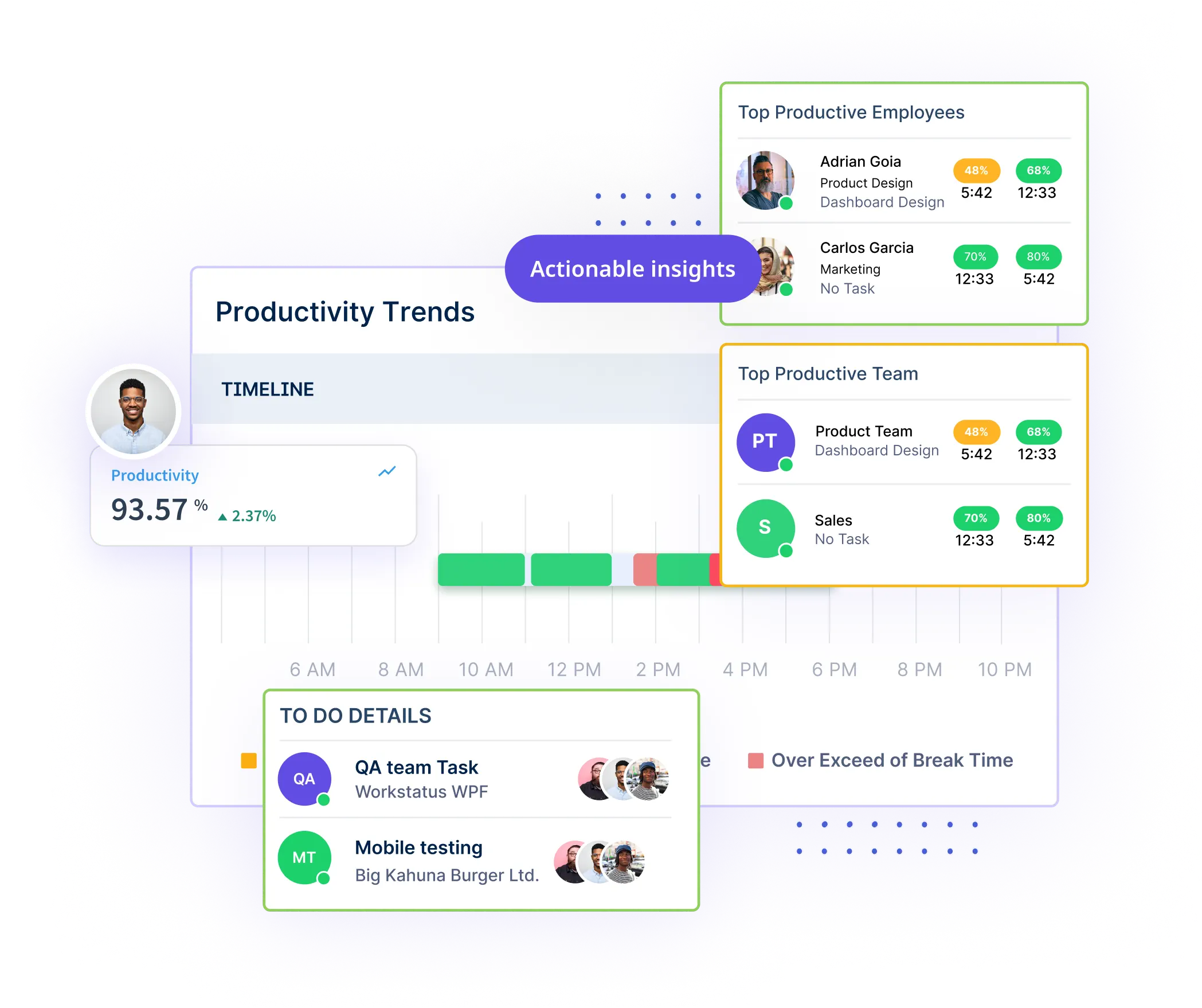 With in-depth productivity reports from Workstatus, organizations can examine teams’ performance in real-time.
With in-depth productivity reports from Workstatus, organizations can examine teams’ performance in real-time.
These reports indicate hours worked, task completion rates, and overall output, allowing managers to identify top performers and areas needing improvement.
Accurate Location Analytics
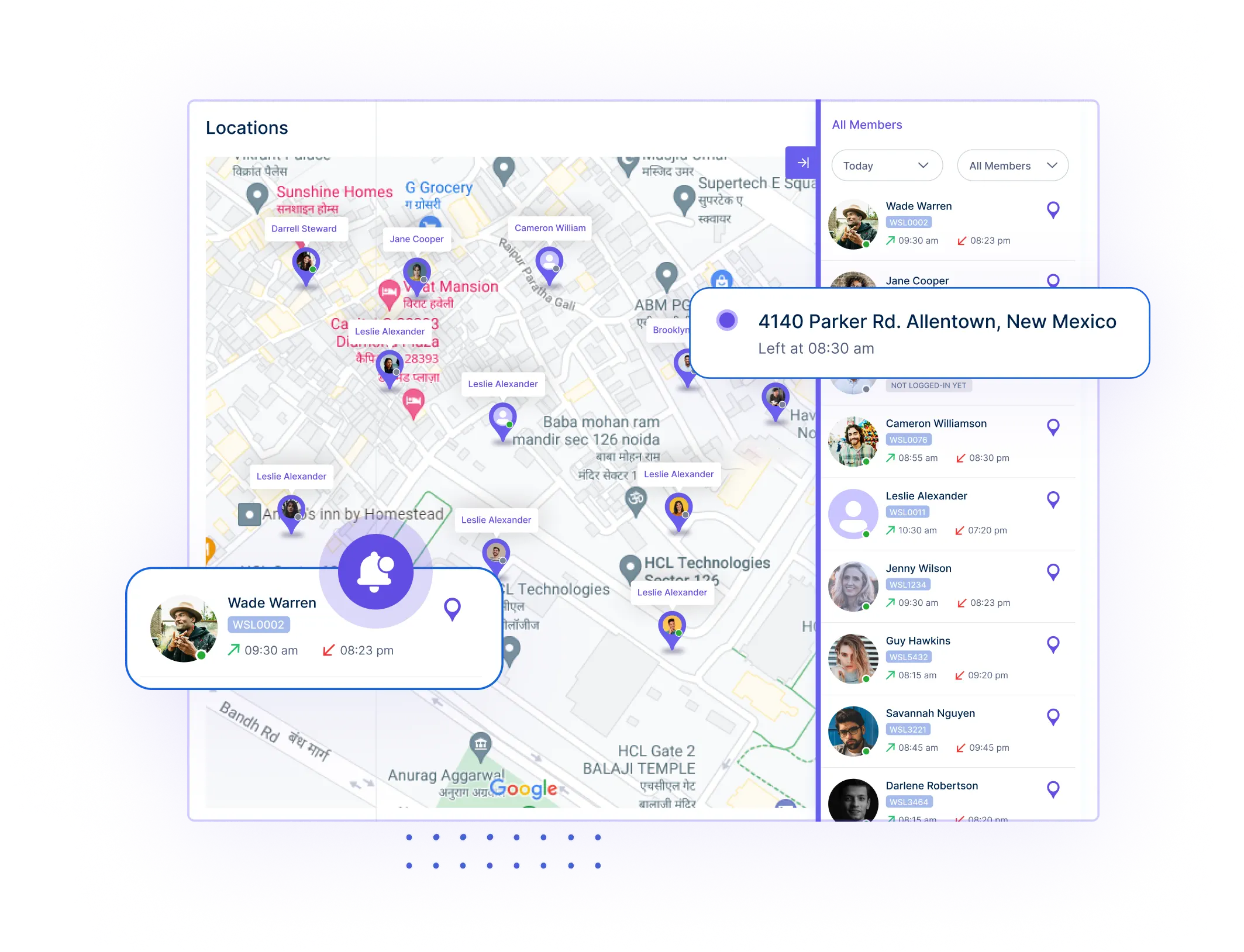 Track and verify employee locations in real-time through Workstatus’s accurate location analytics.
Track and verify employee locations in real-time through Workstatus’s accurate location analytics.
This feature ensures real-time workforce tracking, whether teams are on-site or remote. It provides valuable insight into team movements, enabling organizations to manage their remote workforce and ensure compliance effectively.
Streamlined Workload Management
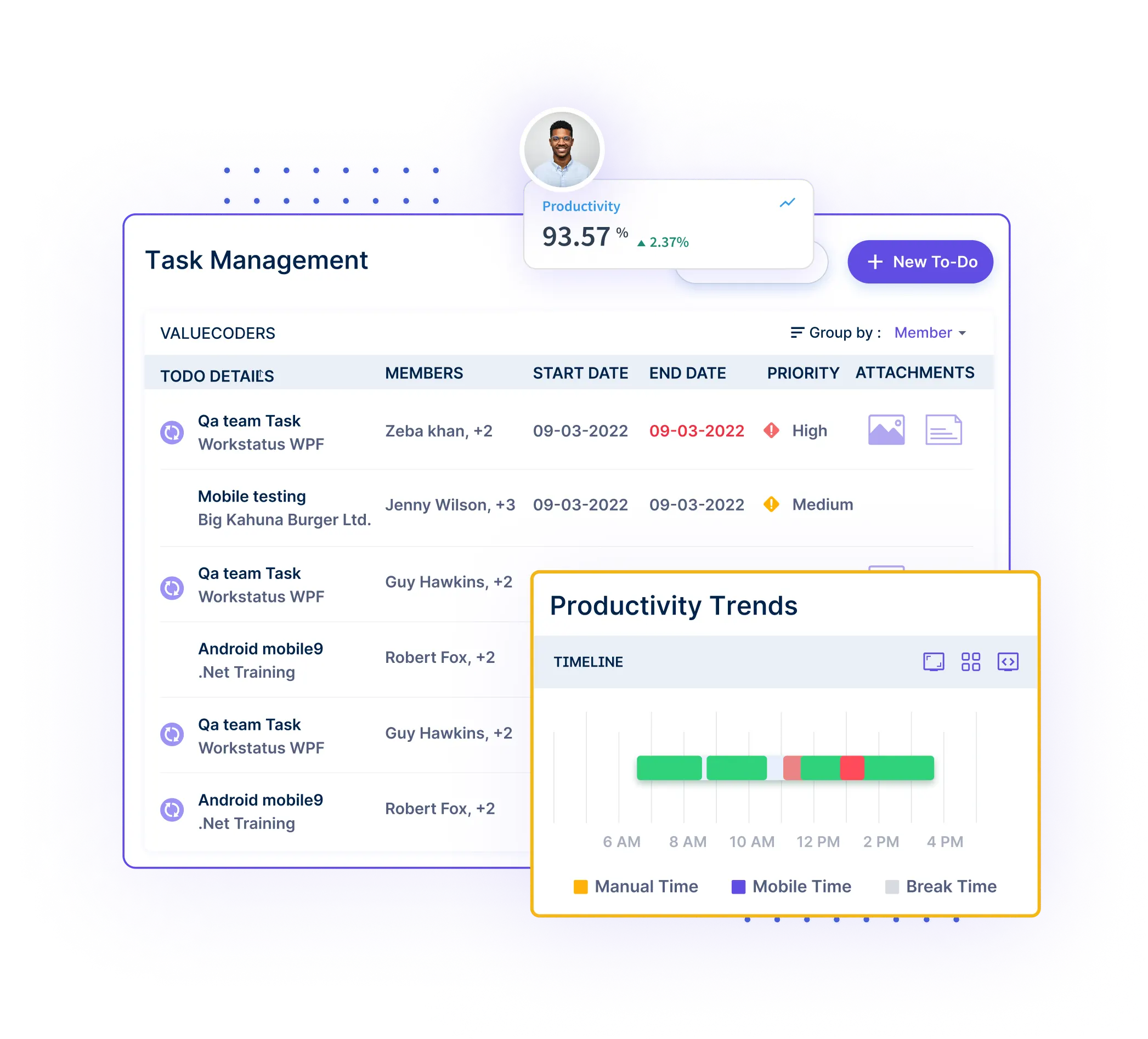 Workload management becomes extremely easy with Workstatus, which features tools to balance team workloads effectively.
Workload management becomes extremely easy with Workstatus, which features tools to balance team workloads effectively.
Managers can assign tasks, track progress, and monitor workloads to ensure employees are not overloaded. This feature allows organizations to increase productivity and mitigate stress while preventing burnout.
Precise Overtime Tracker
![]() Workstatus’s effective overtime tracker ensures proper tracking of overtime hours, thus controlling labor costs.
Workstatus’s effective overtime tracker ensures proper tracking of overtime hours, thus controlling labor costs.
Real-time data lets a supervisor determine when an employee is approaching overtime, allowing corrective action to be taken if needed.
Insightful Performance Analytics
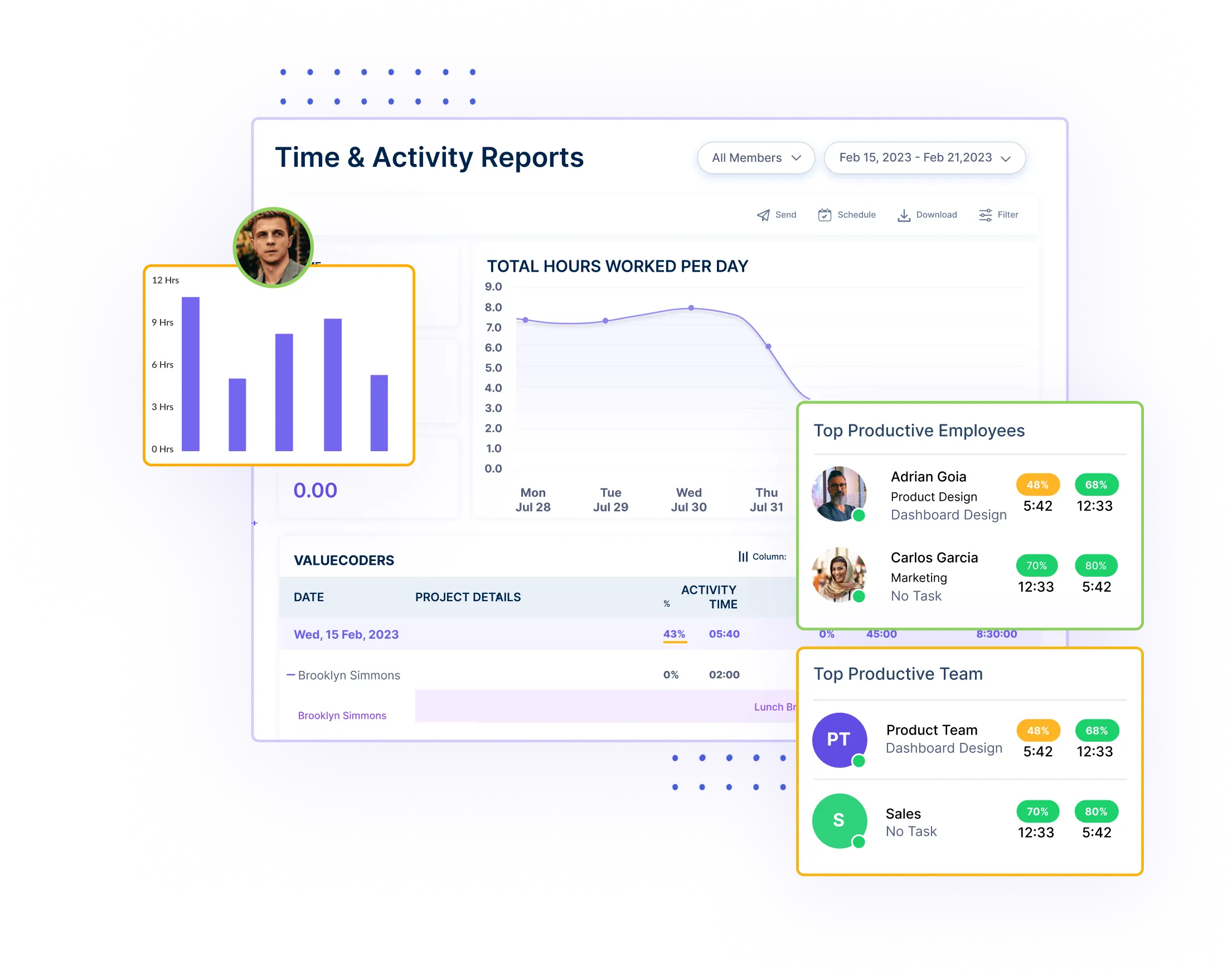 Workstatus proudly offers valuable employee performance analytics for organizations that evaluate individual and team performance levels.
Workstatus proudly offers valuable employee performance analytics for organizations that evaluate individual and team performance levels.
Hitting the mark on their performance metrics can indicate trends that allow managers to be more targeted in their feedback and implement strategies to advance performance and satisfaction across the workforce.
By streamlining workload management and offering detailed employee performance insights, Workstatus ensures that businesses can meet their current needs and anticipate and address future workforce challenges.
7 Simple Steps to Implement Workforce Analytics
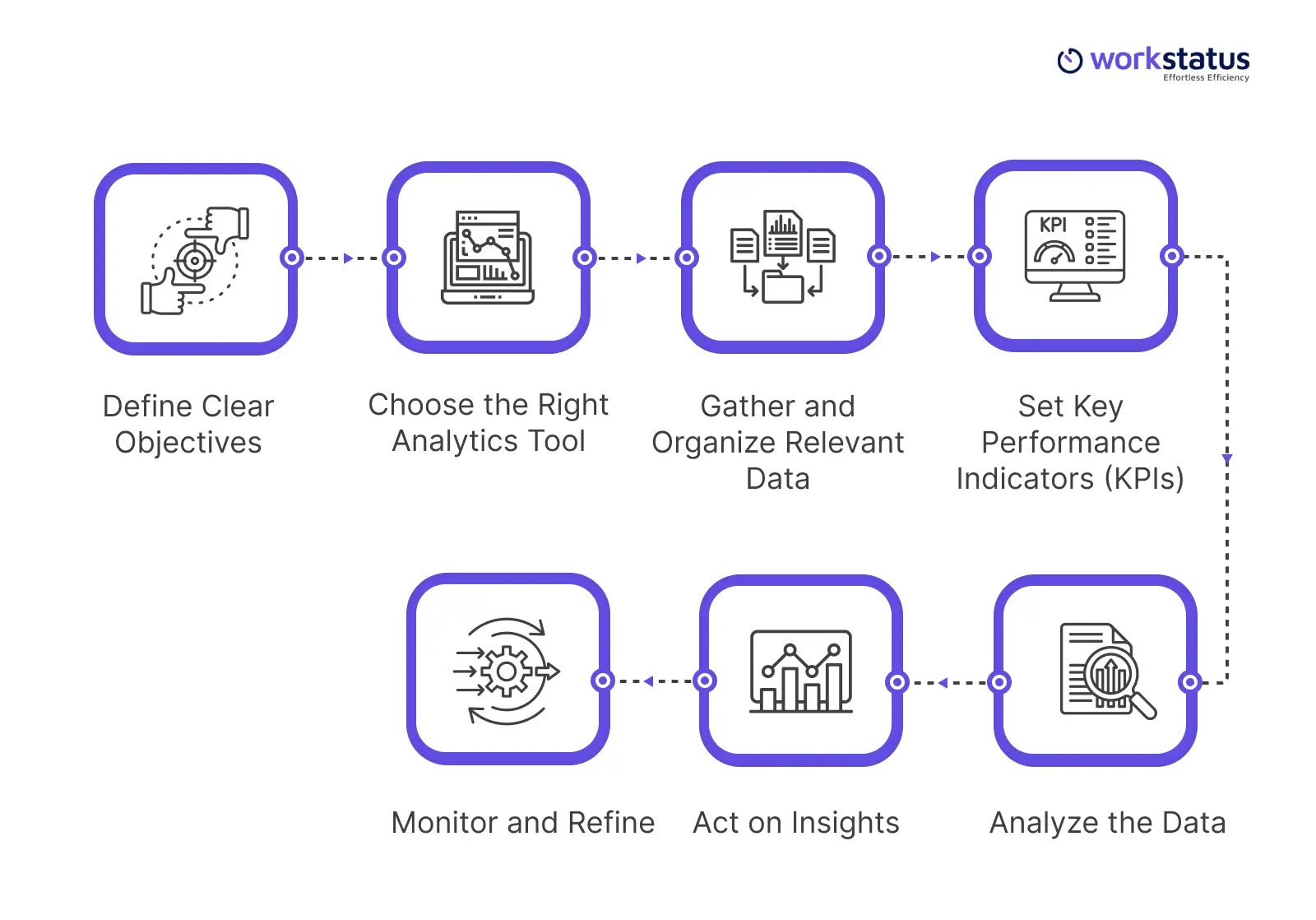 Implementing workforce analytics may sound complicated, yet it cannot be less so-it’s measurable. However, the rewards are plenty.
Implementing workforce analytics may sound complicated, yet it cannot be less so-it’s measurable. However, the rewards are plenty.
With a clear strategy and workforce analytics tools, companies can synthesize their workforce data to enable sound decision-making, operational efficiencies, and improved productivity.
In this section, we’ll highlight seven simple steps to implement workforce analytics and reap its benefits:
Define Clear Objectives
First, identify organizational goals. Separating aims, such as stopping turnover, increasing productivity, or increasing the optimal allocation of resources, helps collect targeted data that can be acted upon.
Further, these objectives must be expressed and measured, and performance, changes made, or strategies should be curtailed accordingly.
Choose the Right Analytics Tool
Choosing the right tool can make a huge difference, yet it may be a tough process to accomplish. Opt for a tool that can be easily synchronized with other programs and systems, such as payrolls and task trackers, and helps you track your employees’ performance in real time.
To get the most out of these platforms, it should also come equipped with some features, such as the ability to generate capped reports and forecasts and an interface that is as simple as possible.
Gather and Organize Relevant Data
Data collection remains critical, more so when it comes in the right and complete form, for building workforce analytics. Collect information from available sources from your organization, including clock records, appraisals, sign-in sheets, and attitude questionnaires.
Once the information has been gathered, the data must be accurate and possess no gaps, double entries, or errors. Accurate data has more value because it requires less time to analyze and means more timely data-driven decisions will be made.
Set Key Performance Indicators (KPIs)
For this reason, a workforce strategy must be developed using other KPIs to assess the success of the progress and the plan to be made. Some parameters include employee efficiency, attrition, and staff satisfaction indices.
It will provide goals that need to be achieved to indicate your success and inform your future endeavors. These factors should be reviewed and revised when necessary for their relevance to your work concerning new business goals.
Analyze the Data
After that, use your analytics tool to analyze as much of the data you have collected as possible. Always analyze data regarding trends, patterns, and relations to improve decision-making.
For instance, you may observe many people absent from work in some departments or low participation rates coupled with massive turnover. It is much more valuable to be prepared before market trends or the demand for the workforce turn down.
Act on Insights
After the data has been analyzed, the next step is to consider what can be done based on the results. When figures indicate that certain groups have been underachieving, more training may be offered, or structures may be reviewed.
If engagement levels are low, consider launching targeted employee engagement programs. Always remember that immediate actions could have the most significant effect on workforce and business outcomes.
Monitor and Refine
Workforce analytics is a continuous process. You should continuously review your KPIs to track progress and evaluate the effectiveness of your strategies.
Be open to refinements based on fresh employee performance insights and feedback. Review the data daily to align with the business’s new reality and optimize workforce strategies over time.
Through these seven steps, businesses are now armed to leverage workforce analytics to make data-driven decisions that support employee performance and a more productive and engaged workforce.
Closing Thoughts
In conclusion, workforce analytics is a tool that significantly impacts business decisions. Companies can minimize their expenses using data on performance, productivity, and new workplace issues.
From optimizing your talent acquisition strategy to engaging your employees better, the ideas derived from workforce analytics inform better strategic decisions and strategy. Thus, using the guidelines presented in this article, you can make the best of your employees and beat the competition.
Workforce analytics is about accumulating data and utilizing that data to develop the best strategies for affecting employee satisfaction and organizational structure.
Are you willing to transform your business? Workstatus is easy to use, all-encompassing, and produces easily actionable workforce analytics.
Begin reaping the benefits of data today with Workstatus and see your workforce and your business grow.
FAQs
Ques: What are the key metrics in workforce analytics?
Ans: Metrics include employee productivity, turnover rates, engagement levels, resource utilization, and overtime costs.
Ques: How does Workstatus simplify workforce analytics?
Ans: Workstatus offers tools like real-time dashboards, productivity reports, and predictive analytics, making data-driven decision-making seamless.
Ques: Can small businesses benefit from workforce analytics?
Ans: Absolutely! Workforce analytics helps businesses optimize resources, reduce costs, and improve employee management.




